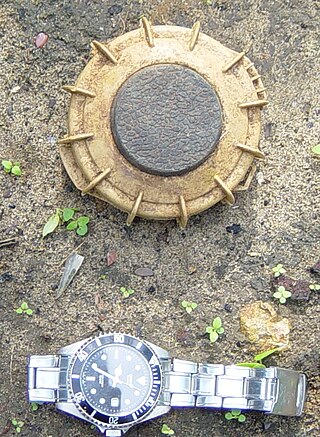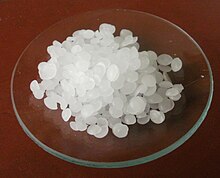
RDX (abbreviation of "Research Department eXplosive") or hexogen, among other names, is an organic compound with the formula (O2N2CH2)3. It is white, odorless and tasteless, widely used as an explosive. Chemically, it is classified as a nitroamine alongside HMX, which is a more energetic explosive than TNT. It was used widely in World War II and remains common in military applications.

An explosive is a reactive substance that contains a great amount of potential energy that can produce an explosion if released suddenly, usually accompanied by the production of light, heat, sound, and pressure. An explosive charge is a measured quantity of explosive material, which may either be composed solely of one ingredient or be a mixture containing at least two substances.

Paraffin wax is a soft colorless solid derived from petroleum, coal, or oil shale that consists of a mixture of hydrocarbon molecules containing between 20 and 40 carbon atoms. It is solid at room temperature and begins to melt above approximately 37 °C (99 °F), and its boiling point is above 370 °C (698 °F). Common applications for paraffin wax include lubrication, electrical insulation, and candles; dyed paraffin wax can be made into crayons. It is distinct from kerosene and other petroleum products that are sometimes called paraffin.

Trinitrotoluene, more commonly known as TNT, more specifically 2,4,6-trinitrotoluene, and by its preferred IUPAC name 2-methyl-1,3,5-trinitrobenzene, is a chemical compound with the formula C6H2(NO2)3CH3. TNT is occasionally used as a reagent in chemical synthesis, but it is best known as an explosive material with convenient handling properties. The explosive yield of TNT is considered to be the standard comparative convention of bombs and asteroid impacts. In chemistry, TNT is used to generate charge transfer salts.

Pentaerythritol tetranitrate (PETN), also known as PENT, PENTA, TEN, corpent, or penthrite, is an explosive material. It is the nitrate ester of pentaerythritol, and is structurally very similar to nitroglycerin. Penta refers to the five carbon atoms of the neopentane skeleton. PETN is a very powerful explosive material with a relative effectiveness factor of 1.66. When mixed with a plasticizer, PETN forms a plastic explosive. Along with RDX it is the main ingredient of Semtex and C4.

Waxes are a diverse class of organic compounds that are lipophilic, malleable solids near ambient temperatures. They include higher alkanes and lipids, typically with melting points above about 40 °C (104 °F), melting to give low viscosity liquids. Waxes are insoluble in water but soluble in nonpolar organic solvents such as hexane, benzene and chloroform. Natural waxes of different types are produced by plants and animals and occur in petroleum.

C-4 or Composition C-4 is a common variety of the plastic explosive family known as Composition C, which uses RDX as its explosive agent. C-4 is composed of explosives, plastic binder, plasticizer to make it malleable, and usually a marker or odorizing taggant chemical. C-4 has a texture similar to modelling clay and can be molded into any desired shape. C-4 is relatively insensitive and can be detonated only by the shock wave from a detonator or blasting cap.

Paint stripper or paint remover is a chemical product designed to remove paint, finishes, and coatings, while also cleaning the underlying surface.

Composition B, colloquially Comp B, is a high explosive consisting of castable mixtures of RDX and TNT. It is used as the main explosive filling in artillery projectiles, rockets, land mines, hand grenades and various other munitions. It was also used for the explosive lenses in the first implosion-type nuclear weapons developed by the United States.

Carnauba, also called Brazil wax and palm wax, is a wax of the leaves of the carnauba palm Copernicia prunifera, a plant native to and grown only in the northeastern Brazilian states of Ceará, Piauí, Pernambuco, Rio Grande do Norte, Maranhão and Bahia. It is known as the "Queen of Waxes". In its pure state, it is usually available in the form of hard yellow-brown flakes. It is obtained by collecting and drying the leaves, beating them to loosen the wax, then refining and bleaching it. As a food additive, its E number is E903.

Torpex is a secondary explosive, 50% more powerful than TNT by mass. Torpex comprises 42% RDX, 40% TNT and 18% powdered aluminium. It was used in the Second World War from late 1942, at which time some used the names Torpex and RDX interchangeably, much to the confusion of today's historical researchers. Torpex proved to be particularly useful in underwater munitions because the aluminium component had the effect of making the explosive pulse last longer, which increased the destructive power. Besides torpedoes, naval mines, and depth charges, Torpex was only used in the Upkeep, Tallboy and Grand Slam bombs as well as the drones employed in Operation Aphrodite. Torpex has long been superseded by H6 and Polymer-bonded explosive (PBX) compositions. It is therefore regarded as obsolete and Torpex is unlikely to be encountered except in old munitions or unexploded ordnance, although a notable exception to this is the Sting Ray lightweight torpedo, which as of October 2020 remains in service with the Royal Navy and several foreign militaries. The German equivalent of Torpex was Trialen.
Baratol is an explosive made of a mixture of TNT and barium nitrate, with a small quantity of paraffin wax used as a phlegmatizing agent. TNT typically makes up 25% to 33% of the mixture. Because of the high density of barium nitrate, Baratol has a density of at least 2.5 g/cm3.
A binder or binding agent is any material or substance that holds or draws other materials together to form a cohesive whole mechanically, chemically, by adhesion or cohesion.
The following is a list of ammunition fired by the 125 mm smoothbore gun series used in the T-64, T-72, T-80, M-84, T-90, PT-91, T-14 Armata, and other tanks derived from those designs, as well as the 2A45 Sprut anti-tank gun.

A thickening agent or thickener is a substance which can increase the viscosity of a liquid without substantially changing its other properties. Edible thickeners are commonly used to thicken sauces, soups, and puddings without altering their taste; thickeners are also used in paints, inks, explosives, and cosmetics.

The PMN series of blast anti-personnel mines were designed and manufactured in the Soviet Union. They are one of the most widely used and commonly found devices during demining operations. They are sometimes nicknamed "black widow" because of their dark casings.

The VS-MK-2 is a plastic bodied scatterable anti-personnel blast mine manufactured by the now-defunct Valsella Meccanotecnica, SpA, an Italian high-tech defence contractor that specialized in the development and production of area denial systems. The mine is extremely difficult to detect because of its low metal content i.e. it is a minimum metal mine. Additionally, it is resistant to blast overpressure due to a pneumatic system in the fuze. The mine will also function in up to 1 metre of water. An electrically fused anti-handling version of the mine was also produced designated VS-MK-2-EL, VS-MK-2-E or VS-MK2 AR-AN to hinder clearance attempts. Although Italy has ceased production of this mine it may still be found in uncleared minefields located in Angola, Sudan and the Western Sahara.

The VS-50 is a circular plastic-cased anti-personnel blast mine that entered production in 1985. It was formerly made by the now-defunct Valsella Meccanotecnica SpA, an Italian high-tech defence company specialized in area denial systems. The company also the made the Valmara 69, and was one of the first to implement plastic construction for landmines. The VS-50's design is similar to that of the TS-50 and VS-MK2 mines. It is blast resistant and can be used in a minimum metal configuration. Though unlikely to kill, its explosive charge is quite sufficient to destroy the victim's foot, being capable of penetrating 5 mm of mild steel leaving an 80 mm-diameter hole.
Composition H6 is a castable military explosive mixture composed of the following percentages by weight:

The F1 grenade is manufactured by Thales Australia exclusively for the Australian Defence Force as a primary defensive anti-personnel hand grenade.
















